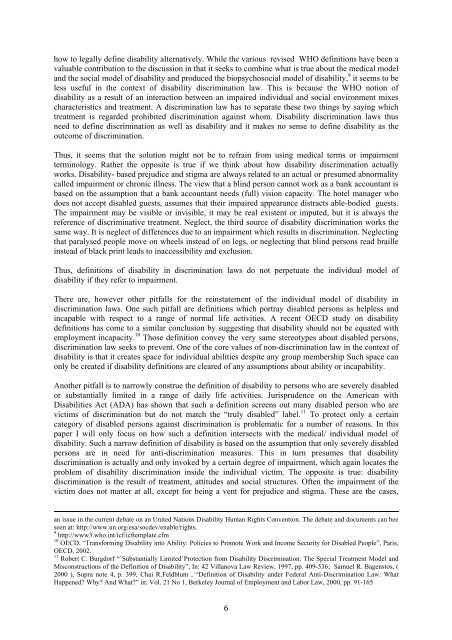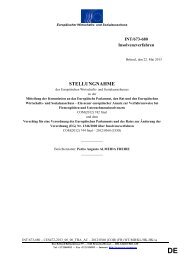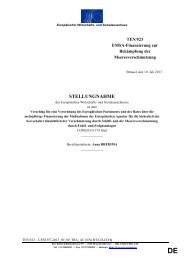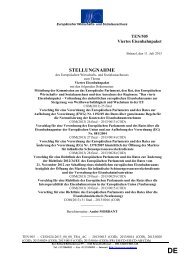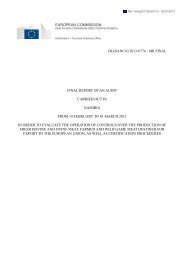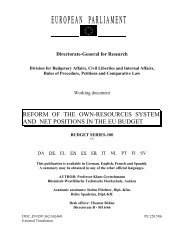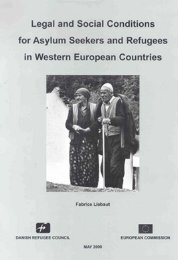Definition of disability
Definition of disability
Definition of disability
You also want an ePaper? Increase the reach of your titles
YUMPU automatically turns print PDFs into web optimized ePapers that Google loves.
how to legally define <strong>disability</strong> alternatively. While the various revised WHO definitions have been a<br />
valuable contribution to the discussion in that it seeks to combine what is true about the medical model<br />
and the social model <strong>of</strong> <strong>disability</strong> and produced the biopsychosocial model <strong>of</strong> <strong>disability</strong>, 9 it seems to be<br />
less useful in the context <strong>of</strong> <strong>disability</strong> discrimination law. This is because the WHO notion <strong>of</strong><br />
<strong>disability</strong> as a result <strong>of</strong> an interaction between an impaired individual and social environment mixes<br />
characteristics and treatment. A discrimination law has to separate these two things by saying which<br />
treatment is regarded prohibited discrimination against whom. Disability discrimination laws thus<br />
need to define discrimination as well as <strong>disability</strong> and it makes no sense to define <strong>disability</strong> as the<br />
outcome <strong>of</strong> discrimination.<br />
Thus, it seems that the solution might not be to refrain from using medical terms or impairment<br />
terminology. Rather the opposite is true if we think about how <strong>disability</strong> discrimination actually<br />
works. Disability- based prejudice and stigma are always related to an actual or presumed abnormality<br />
called impairment or chronic illness. The view that a blind person cannot work as a bank accountant is<br />
based on the assumption that a bank accountant needs (full) vision capacity. The hotel manager who<br />
does not accept disabled guests, assumes that their impaired appearance distracts able-bodied guests.<br />
The impairment may be visible or invisible, it may be real existent or imputed, but it is always the<br />
reference <strong>of</strong> discriminative treatment. Neglect, the third source <strong>of</strong> <strong>disability</strong> discrimination works the<br />
same way. It is neglect <strong>of</strong> differences due to an impairment which results in discrimination. Neglecting<br />
that paralysed people move on wheels instead <strong>of</strong> on legs, or neglecting that blind persons read braille<br />
instead <strong>of</strong> black print leads to inaccessibility and exclusion.<br />
Thus, definitions <strong>of</strong> <strong>disability</strong> in discrimination laws do not perpetuate the individual model <strong>of</strong><br />
<strong>disability</strong> if they refer to impairment.<br />
There are, however other pitfalls for the reinstatement <strong>of</strong> the individual model <strong>of</strong> <strong>disability</strong> in<br />
discrimination laws. One such pitfall are definitions which portray disabled persons as helpless and<br />
incapable with respect to a range <strong>of</strong> normal life activities. A recent OECD study on <strong>disability</strong><br />
definitions has come to a similar conclusion by suggesting that <strong>disability</strong> should not be equated with<br />
employment incapacity. 10 Those definition convey the very same stereotypes about disabled persons,<br />
discrimination law seeks to prevent. One <strong>of</strong> the core values <strong>of</strong> non-discrimination law in the context <strong>of</strong><br />
<strong>disability</strong> is that it creates space for individual abilities despite any group membership Such space can<br />
only be created if <strong>disability</strong> definitions are cleared <strong>of</strong> any assumptions about ability or incapability.<br />
Another pitfall is to narrowly construe the definition <strong>of</strong> <strong>disability</strong> to persons who are severely disabled<br />
or substantially limited in a range <strong>of</strong> daily life activities. Jurisprudence on the American with<br />
Disabilities Act (ADA) has shown that such a definition screens out many disabled person who are<br />
victims <strong>of</strong> discrimination but do not match the “truly disabled” label. 11 To protect only a certain<br />
category <strong>of</strong> disabled persons against discrimination is problematic for a number <strong>of</strong> reasons. In this<br />
paper I will only focus on how such a definition intersects with the medical/ individual model <strong>of</strong><br />
<strong>disability</strong>. Such a narrow definition <strong>of</strong> <strong>disability</strong> is based on the assumption that only severely disabled<br />
persons are in need for anti-discrimination measures. This in turn presumes that <strong>disability</strong><br />
discrimination is actually and only invoked by a certain degree <strong>of</strong> impairment, which again locates the<br />
problem <strong>of</strong> <strong>disability</strong> discrimination inside the individual victim. The opposite is true: <strong>disability</strong><br />
discrimination is the result <strong>of</strong> treatment, attitudes and social structures. Often the impairment <strong>of</strong> the<br />
victim does not matter at all, except for being a vent for prejudice and stigma. These are the cases,<br />
an issue in the current debate on an United Nations Disability Human Rights Convention. The debate and documents can bee<br />
seen at: http://www.un.org/esa/socdev/enable/rights.<br />
9<br />
http://www3.who.int/icf/icftemplate.cfm<br />
10<br />
OECD, “Transforming Disability into Ability: Policies to Promote Work and Income Security for Disabled People”, Paris,<br />
OECD, 2002.<br />
11<br />
Robert C. Burgdorf “`Substantially Limited`Protection from Disability Discrimination: The Special Treatment Model and<br />
Misconstructions <strong>of</strong> the <strong>Definition</strong> <strong>of</strong> Disability”, In: 42 Villanova Law Review, 1997, pp. 409-536; Samuel R. Bagenstos, (<br />
2000 ), Supra note 4, p. 399, Chai R.Feldblum , “<strong>Definition</strong> <strong>of</strong> Disability under Federal Anti-Discrimination Law: What<br />
Happened? Why? And What?” in: Vol. 21 No 1, Berkeley Journal <strong>of</strong> Employment and Labor Law, 2000, pp. 91-165<br />
6


